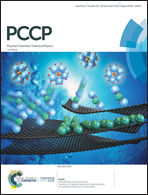To bend or not to bend, the dilemma of multiple bonds†
Abstract
Beyond the second row of the periodic table, the nature of the multiple bonds between the elements of the main groups remains yet elusive, and “non-classical” bonding schemes are often invoked for their description. Here, focusing on group 14, we have performed an accurate modeling of the Si–Si and C–C double bonds, including electron correlation effects. We have shown that Si![[double bond, length as m-dash]](https://www.rsc.org/images/entities/char_e001.gif) Si bonds are “classical” and closely resemble C
Si bonds are “classical” and closely resemble C![[double bond, length as m-dash]](https://www.rsc.org/images/entities/char_e001.gif) C ones, being similarly subjected to a sort of tug of war in which the σ bond favors distortion and the π bond opposes it. The essential difference between Si and C boils down to the sizes of their valence shells, which determine the π-bending stiffness. In carbon, such a stiffness is large because, upon bending, the atomic s orbitals interfere destructively with the p ones. In silicon, the s shell is smaller than the p one, the bending stiffness is reduced and the π bonds typically succumb, distort, and weaken. Electron correlation plays a major role in this context, since π bonds are far from their molecular orbital limit. Hence, we have further shown that upon weakening the effective repulsion between π electrons one may remove any structural instability, strengthen the π bonds and turn Si into a closer relative of C than it used to be.
C ones, being similarly subjected to a sort of tug of war in which the σ bond favors distortion and the π bond opposes it. The essential difference between Si and C boils down to the sizes of their valence shells, which determine the π-bending stiffness. In carbon, such a stiffness is large because, upon bending, the atomic s orbitals interfere destructively with the p ones. In silicon, the s shell is smaller than the p one, the bending stiffness is reduced and the π bonds typically succumb, distort, and weaken. Electron correlation plays a major role in this context, since π bonds are far from their molecular orbital limit. Hence, we have further shown that upon weakening the effective repulsion between π electrons one may remove any structural instability, strengthen the π bonds and turn Si into a closer relative of C than it used to be.

- This article is part of the themed collection: 2019 PCCP HOT Articles


 Please wait while we load your content...
Please wait while we load your content...